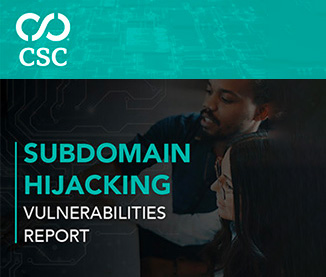

Brand Protection |
Sponsored by |

|



 In this article, I present an overview of a series of 'proof-of-concept' studies looking at the application of domain-name entropy as a means of clustering together related domain registrations, and serving as an input into potential metrics to determine the likely level of threat which may be posed by a domain. more
In this article, I present an overview of a series of 'proof-of-concept' studies looking at the application of domain-name entropy as a means of clustering together related domain registrations, and serving as an input into potential metrics to determine the likely level of threat which may be posed by a domain. more
 In 2014, computer scientist Gavin Wood coined the term "Web 3.0." The phrase, which has now been shortened to "Web3", refers to the third generation of the internet that's designed to be truly decentralised and free from a central authority. Web3 has the potential to add real-world value for businesses by creating additional avenues to reach consumers. However, owing to its less regulated nature, brands also have the potential to be taken advantage of both by users and by the providers in the space. more
In 2014, computer scientist Gavin Wood coined the term "Web 3.0." The phrase, which has now been shortened to "Web3", refers to the third generation of the internet that's designed to be truly decentralised and free from a central authority. Web3 has the potential to add real-world value for businesses by creating additional avenues to reach consumers. However, owing to its less regulated nature, brands also have the potential to be taken advantage of both by users and by the providers in the space. more
 As the brand protection industry approaches a quarter of a century in age, following the founding of pioneers Envisional and MarkMonitor in 1999, I present an overview of some of the main outstanding issues which are frequently unaddressed or are generally only partially solved by brand protection service providers. I term these the 'Millennium Problems' in reference to the set of unsolved mathematical problems published in 2000 by the Clay Mathematics Institute, and for which significant prizes were offered for solutions. more
As the brand protection industry approaches a quarter of a century in age, following the founding of pioneers Envisional and MarkMonitor in 1999, I present an overview of some of the main outstanding issues which are frequently unaddressed or are generally only partially solved by brand protection service providers. I term these the 'Millennium Problems' in reference to the set of unsolved mathematical problems published in 2000 by the Clay Mathematics Institute, and for which significant prizes were offered for solutions. more
 Unsuspecting website visitors are often unaware when they have landed on a spoofed page or are re-directed to malware-hosting web servers designed to steal their sensitive data and information. This attack is known as subdomain hijacking, or subdomain takeover. A web user's private information is then traded on the dark web, and cybercriminals profit, further fueling the expansion of identity theft in the online world. more
Unsuspecting website visitors are often unaware when they have landed on a spoofed page or are re-directed to malware-hosting web servers designed to steal their sensitive data and information. This attack is known as subdomain hijacking, or subdomain takeover. A web user's private information is then traded on the dark web, and cybercriminals profit, further fueling the expansion of identity theft in the online world. more
 In today's digital age, securing your website and ensuring your users' safety has never been more critical. Secure sockets layer (SSL) certificates are the go-to solution for securing websites by encrypting the data transmitted between web servers and browsers. Historically, SSL digital certificates could be valid for years, after which they had to be renewed or replaced. more
In today's digital age, securing your website and ensuring your users' safety has never been more critical. Secure sockets layer (SSL) certificates are the go-to solution for securing websites by encrypting the data transmitted between web servers and browsers. Historically, SSL digital certificates could be valid for years, after which they had to be renewed or replaced. more
 Last month, the U.S. National Cybersecurity Strategy was launched, providing a new roadmap for stronger collaboration between those operating within the digital ecosystem. The strategy calls on software makers and American industry to take far greater responsibility to assure that their systems cannot be hacked while accelerating efforts by the Federal Bureau of Investigation and the Defense Department to disrupt the activities of hackers and ransomware groups around the world. more
Last month, the U.S. National Cybersecurity Strategy was launched, providing a new roadmap for stronger collaboration between those operating within the digital ecosystem. The strategy calls on software makers and American industry to take far greater responsibility to assure that their systems cannot be hacked while accelerating efforts by the Federal Bureau of Investigation and the Defense Department to disrupt the activities of hackers and ransomware groups around the world. more
 Brand impersonation happens much more often than people realize. In CSC's latest Domain Security Report, we found that 75% of domains for the Global 2000 that contained more than six characters from the brand names were not actually owned by the brands themselves. The intent of these fake domain registrations is to leverage the trust placed on the targeted brands to launch phishing attacks, other forms of digital brand abuse, or IP infringement... more
Brand impersonation happens much more often than people realize. In CSC's latest Domain Security Report, we found that 75% of domains for the Global 2000 that contained more than six characters from the brand names were not actually owned by the brands themselves. The intent of these fake domain registrations is to leverage the trust placed on the targeted brands to launch phishing attacks, other forms of digital brand abuse, or IP infringement... more
 Domain tasting is a long-established practice involving the short-lived existence of a domain, which is allowed to lapse a few days after its initial registration. The practice arose in response to an Internet Corporation for Assigned Names and Numbers (ICANN) policy allowing a domain to be cancelled -- with all fees refunded -- within a five-day grace period, intended to address the issue of accidental registrations1. However, the practice is open to abuse by infringers. more
Domain tasting is a long-established practice involving the short-lived existence of a domain, which is allowed to lapse a few days after its initial registration. The practice arose in response to an Internet Corporation for Assigned Names and Numbers (ICANN) policy allowing a domain to be cancelled -- with all fees refunded -- within a five-day grace period, intended to address the issue of accidental registrations1. However, the practice is open to abuse by infringers. more
Today, the FCC has sided with Amazon in a regulatory battle over Project Kuiper, the company's satellite internet system. Despite objections from rival SpaceX, the commission has approved Amazon's plan to prevent the upcoming satellite internet constellation from causing orbital debris in space. more
 I'm asked at least twenty times a year how a small ISP can compete against the big cable companies. The question comes from several sources - a newly-formed ISP that is nervous about competing against a giant company, a rural ISP that is entering a larger market to compete, or investors thinking of funding a new ISP. These folks are rightfully nervous about competing against the big cable companies. more
I'm asked at least twenty times a year how a small ISP can compete against the big cable companies. The question comes from several sources - a newly-formed ISP that is nervous about competing against a giant company, a rural ISP that is entering a larger market to compete, or investors thinking of funding a new ISP. These folks are rightfully nervous about competing against the big cable companies. more
 Blockchain domain names, domains that are stored on blockchain or cryptocurrency exchanges, are part of a growing, unregulated, and decentralized internet. Right now, blockchain domains are used mostly by cryptocurrency users, but they are growing in popularity - the Ethereum name service reported over 2.2 million .eth domain name registrations in 2022. At the same time, crypto scams are also exploding, reaching a total of $3.5 billion in losses in 2022. more
Blockchain domain names, domains that are stored on blockchain or cryptocurrency exchanges, are part of a growing, unregulated, and decentralized internet. Right now, blockchain domains are used mostly by cryptocurrency users, but they are growing in popularity - the Ethereum name service reported over 2.2 million .eth domain name registrations in 2022. At the same time, crypto scams are also exploding, reaching a total of $3.5 billion in losses in 2022. more
 In the first article of this two-part blog series, we looked at how frequently domains were used by bad actors for phishing activity across individual top-level domains (TLDs) or domain extensions, using data from CSC's Fraud Protection services, powered by our DomainSecSM platform. In this second article, we analyze multiple datasets to determine the highest-threat TLDs, based on the frequency with which the domains are used egregiously for a range of cybercrimes. more
In the first article of this two-part blog series, we looked at how frequently domains were used by bad actors for phishing activity across individual top-level domains (TLDs) or domain extensions, using data from CSC's Fraud Protection services, powered by our DomainSecSM platform. In this second article, we analyze multiple datasets to determine the highest-threat TLDs, based on the frequency with which the domains are used egregiously for a range of cybercrimes. more
 Having been involved in this sector for over fifteen years now, the rate of change in the market dynamics continues to surprise me - from its early years when MarkMonitor and NetNames clearly led the space for several years, then seeing well-funded startups such as Yellow Brand Protection and Incopro challenge that, followed by a period of heavy M&A, it is now extremely diverse. more
Having been involved in this sector for over fifteen years now, the rate of change in the market dynamics continues to surprise me - from its early years when MarkMonitor and NetNames clearly led the space for several years, then seeing well-funded startups such as Yellow Brand Protection and Incopro challenge that, followed by a period of heavy M&A, it is now extremely diverse. more
 There was an interesting phenomenon that happened in September when Starlink launched 49 new satellites. The satellites were successfully deployed by the rocket, but as the satellites were being maneuvered to reach the final orbital slots, there was a geomagnetic storm that caused 38 of the satellites to fall back to earth. Space storms happen when radiation affects the magnetosphere that surrounds the earth. more
There was an interesting phenomenon that happened in September when Starlink launched 49 new satellites. The satellites were successfully deployed by the rocket, but as the satellites were being maneuvered to reach the final orbital slots, there was a geomagnetic storm that caused 38 of the satellites to fall back to earth. Space storms happen when radiation affects the magnetosphere that surrounds the earth. more
 Undersea cables between the U. S. and Cuba have long been intertwined with politics. In 1887, The New York Times reported on the inauguration of a cable in support of the Cuban insurgents fighting for independence from Spain -- a precursor to the Spanish-American war. Phone service between the U.S. and Cuba began in 1921 with AT&T's installation of an undersea cable and AT&T dominated international telephony to Cuba until the 1990s. more
Undersea cables between the U. S. and Cuba have long been intertwined with politics. In 1887, The New York Times reported on the inauguration of a cable in support of the Cuban insurgents fighting for independence from Spain -- a precursor to the Spanish-American war. Phone service between the U.S. and Cuba began in 1921 with AT&T's installation of an undersea cable and AT&T dominated international telephony to Cuba until the 1990s. more